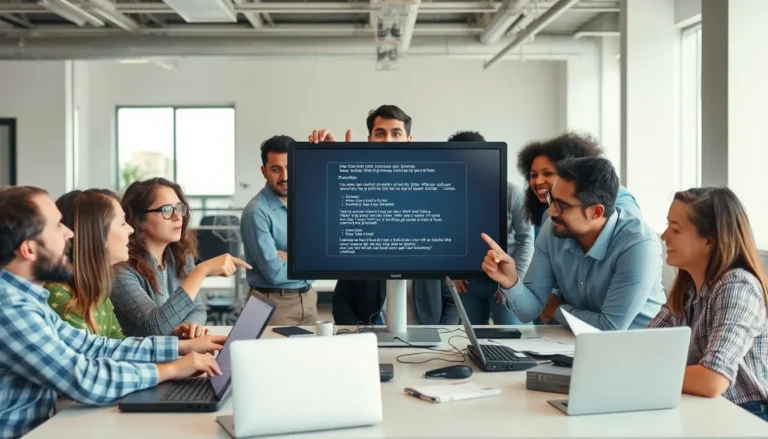Table of Contents
ToggleUpdating software might not be the most thrilling task on a to-do list, but when it comes to Endbugflow, it’s like giving your PC a refreshing spa day. Imagine your computer gliding through tasks with the grace of a gazelle instead of the sluggishness of a sloth. Who wouldn’t want that?
Understanding Endbugflow Software
Endbugflow software serves as an essential tool for managing workflows and enhancing productivity. Users benefit from its features that streamline processes, making tasks easier and more efficient. Designed for both individual and team use, it adapts to various operational needs.
Advanced functionality allows for real-time collaboration, enabling users to share updates immediately. Integration with other productivity tools enhances its versatility, allowing seamless data movement between applications. Regular updates introduce new features and improvements, keeping the software current and effective.
Security remains a top priority, as updates also address vulnerabilities, protecting user data. System performance receives a significant boost with each update, optimizing resource usage and providing faster response times. With an intuitive interface, navigating through its features proves effortless for users.
Endbugflow’s robust customization options empower users to tailor the software to their specific requirements. Performance metrics offer valuable insights, helping users make informed decisions to improve their workflows. By leveraging these features, teams can enhance productivity and meet deadlines more effectively.
Overall, understanding Endbugflow software and its capabilities highlights the importance of updates. Keeping the software current maximizes its potential, ensuring users exploit all available benefits. Embracing these updates fosters an improved experience across all usage scenarios.
Preparing for the Update

Updating Endbugflow software requires proper preparation to ensure a seamless experience. Following specific steps can help prevent issues and optimize performance.
Checking System Requirements
Confirming that the PC meets the system requirements is essential for a successful update. Endbugflow’s specifications typically include details about the necessary operating system, processor type, RAM, and available disk space. Users must verify the current system configuration before proceeding. Compatibility with other installed software may also affect the update process. If the requirements aren’t met, performance issues might arise post-update. Refer to the official Endbugflow documentation to access the most accurate system requirements.
Backing Up Important Data
Backing up important data safeguards against potential data loss during the update process. Users should create copies of their workflow files, settings, and any project-related documentation. Cloud storage services or external drives can serve as reliable backup solutions. By ensuring data is secure, users mitigate risks associated with update failures or errors. After completing the backup, it’s wise to check recovery options to confirm their functionality. Taking these precautions can lead to a smoother transition and uninterrupted work.
Steps to Update Endbugflow Software on PC
Updating Endbugflow software on a PC involves a series of straightforward steps that enhance functionality and security. Follow these instructions for a seamless transition.
Downloading the Latest Version
Start by visiting the official Endbugflow website. Navigate to the downloads section, where users can find the most recent software version. Click on the download button for the latest release compatible with your operating system. The download process usually finishes within a few minutes. Once completed, check the downloads folder for the installation file.
Uninstalling the Old Version
Before installing the new version, uninstall the previous one to prevent conflicts. Access the Control Panel from the start menu. Locate the “Programs” or “Programs and Features” section, and find Endbugflow in the list of installed software. Click on it, then select the “Uninstall” option. Follow the prompts to complete the uninstallation process. This step ensures a clean slate for installing the new software.
Installing the New Version
Double-click the downloaded installation file to begin the installation process. Follow the on-screen prompts to guide you through the setup. Choose the preferred installation location or proceed with the default option. Configure any necessary settings as needed. Upon completion, launch the new Endbugflow software to verify that the update was successful. Users should notice improved performance and new features immediately.
Troubleshooting Common Update Issues
Users might encounter various issues while updating Endbugflow software. Understanding these common problems can simplify the resolution process.
Network connectivity issues can interrupt the update. They can lead to incomplete downloads and installation failures. Ensuring a stable internet connection is crucial before starting the update process.
Compatibility errors often arise from outdated system configurations. Users should verify that their PC meets the latest system requirements for the Endbugflow update. Upgrading the operating system or specific drivers may be necessary to resolve compatibility issues.
Error messages during installation can be daunting. These messages often indicate conflicts with the existing software version. Uninstalling the old version completely before attempting the new installation can prevent such errors.
Installation hanging can frustrate users. A common reason for this issue is insufficient storage space on the PC. Checking available storage and removing unnecessary files can often resolve this dilemma.
Security software sometimes interferes with the installation process. Antivirus or firewall settings might block the installer from proceeding. Temporarily disabling these programs during the update can lead to a smoother installation.
Reverting back to an older version of Endbugflow can resolve persistent issues after an update. Noticing performance declines may necessitate this step. Users should ensure they back up workflows prior to reverting, allowing for restoration if needed.
In case of unresolved issues after these steps, reaching out to Endbugflow’s customer support can provide expert assistance. They can offer tailored solutions, helping users overcome any additional challenges encountered during the update.
Updating Endbugflow software is essential for maintaining optimal performance and security. By regularly refreshing the software users can take full advantage of its advanced features and improved functionalities. This not only enhances individual productivity but also fosters better collaboration within teams.
Following the outlined steps ensures a smooth update process while addressing potential issues that may arise. Keeping the software current not only protects data but also allows users to tailor their experience to meet specific needs. Embracing these updates is a proactive approach to maximizing the benefits of Endbugflow and achieving greater efficiency in workflow management.




